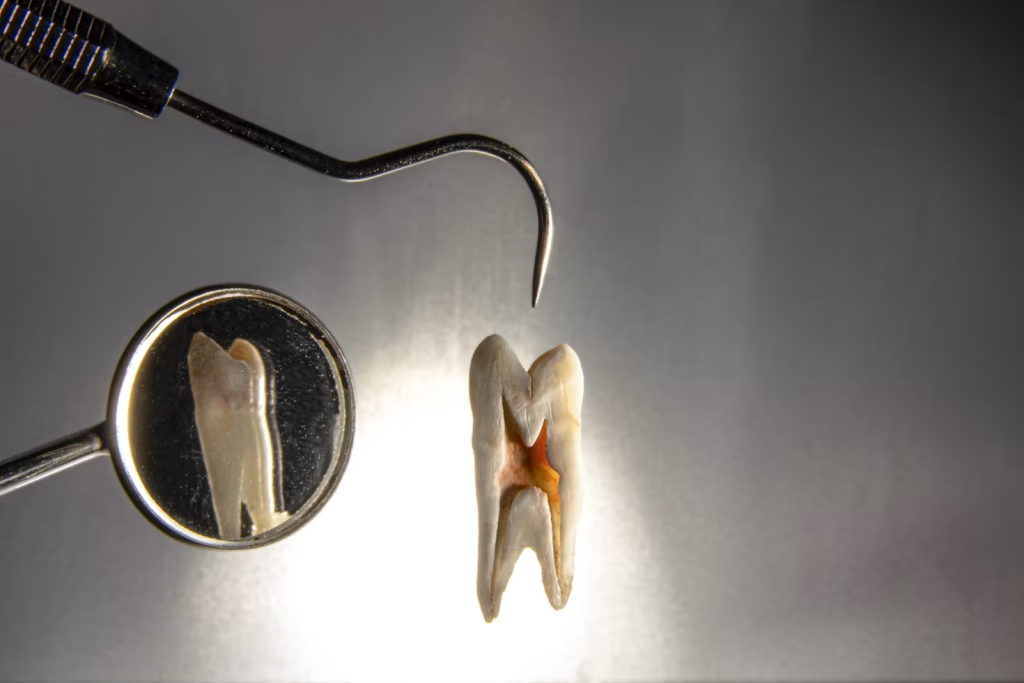In This Article
ToggleA persistent toothache can disturb your daily routine and cause major discomfort. While over-the-counter medications offer temporary relief, root canal treatment provides a permanent solution for infected or damaged teeth. No matter its reputation, the steps of the root canal treatment procedure are simple, safe, and required for preserving your natural teeth.
This blog walks you through the steps of root canal treatment and helps you understand how this effective procedure restores dental health.
What is a Root Canal Treatment?
A root canal treatment is a dental procedure design to treat infection of the dental pulp, which is the innermost structure inside the tooth, carrying all nerves and blood supply. Infection or inflammation of the pulp tissue results in severe pain. If left untreated, a toothache may flare up, exceeding the relief offered by over-the-counter (OTC) medications.
The root canal treatment procedure step by step involves removing the pulp, disinfecting the canals, and sealing the space with a filling material to prevent reinfection.
This treatment requires multiple visits to the dental office.
Why You May Need a Root Canal?
Common reasons for needing a root canal treatment include:
- Deep cavities that reach the pulp chamber
- Cracked or chipped teeth with significant damage to the tooth structure
- Trauma to the tooth, exposing the pulp
- Discolored tooth with signs of internal resorption
- Severe toothache or prolonged sensitivity
- Swelling and abscess in the gums around the affected tooth.
Root Canal Treatment Procedure Step-by-Step
To understand the root canal treatment, let’s break down the steps of the root canal procedure.
Initial Assessment and Diagnosis
The first step of the root canal procedure begins with a thorough clinical evaluation, just as with every other dental procedure. These investigations help to devise an ideal approach to cure the tooth. Assessment includes:
- An oral examination of the affected tooth to check for symptoms, including sensitivity and pain.
- Dental and medical history review to ensure the treatment’s safety.
- Dental X-rays to assess the extent of infection.
Dental X-rays and a clinical examination are necessary to determine if a root canal procedure is need or if other alternatives, such as fillings or extractions, can be employed.
Administration of Local Anesthesia
Once the diagnosis is confirm, your dentist will brief you about the procedure and begin with a patch test for local anesthesia.
Local anesthesia is then used to numb the area around the tooth and allow the procedure to proceed smoothly without discomfort or pain.
Step 1: Tooth Isolation
A rubber dam is place to isolate the area and to protect against any contamination from saliva. It also protects the gums and the rest of the teeth from the chemical agents used during the procedure. Tooth isolation is a vital step of the root canal procedure for maintaining proper hygiene.
Step 2: Access Opening
This step marks the beginning of the root canal procedure. The access opening refers to gently drilling a hole in the affected tooth to acquire access to the pulp chamber and root canals. The access opening creates a pathway for endodontic instruments to reach the thin canals and shape and clean them properly.
Step 3: Pulp Removal
Using endodontic instruments called files, the pulp is removed from the canals. This step eliminates the pain and infection.
Your dentist might clean the canals with saline or a medicated solution to eliminate bacteria and seal the tooth with temporary filling material. Some dentists prefer to shape the canal during the second visit due to time constraints.
Step 4: Cleaning and Shaping of Canals
After removing the pulp, the dentist:
- Cleans the inside of the root canals.
- Shape them to a uniform size using fine dental files. This step is essential as it prepares the canal to receive the filling material.
- Uses antimicrobial solutions to disinfect the area.
Step 5: Canal Filling (Obturation)
Once the canals are properly cleaned and free of any sign of infection, they are filled with Gutta-Percha. It is a biocompatible root-filling material that seals the properly cleaned and shaped canals, thereby preventing reinfection.
Obturation is the final step of the root canal procedure and is usually completed once all the symptoms have subsided. This is followed by placing a temporary filling to close the access opening in the tooth until the permanent restoration is done.
Step 6: Tooth Restoration
The permanent filling is not enough in most cases of root canal therapy. To support the remaining tooth structure, your dentist might recommend that you get a crown placed, especially in molars.
Step 7: Follow-up and Aftercare
After the root canal treatment is complete, your dentist may schedule a follow-up appointment to:
- Ensure proper healing
- Evaluate the success of the treatment
- Place a permanent restoration if not done already
- Patients are advised to follow proper oral hygiene, avoid chewing on the treated tooth until it’s fully restored, and report any unusual discomfort immediately.
Additional Tips for Root Canal Recovery
Recovering from a root canal can be slightly painful. For treatment to be completely successful:
- Take prescribed antibiotics or pain relievers if recommended.
- Avoid hard foods for a few days.
- Excellent oral hygiene with regular brushing and flossing is mandatory.
- Visit your dentist routinely.
Can a Root Canal Last Without a Crown?
In some cases, especially in front teeth with enough structure remaining, a crown may not be immediately necessary. However, molars and premolars almost always need crowns due to their chewing function and structural weakness post-treatment.
Conclusion:
Understanding the steps of the root canal treatment procedure empowers you to make informed decisions about your dental care. Far from being something to fear, root canals are highly effective in saving natural teeth and preventing further complications.
Need Root Canal Treatment? Visit a Trusted Dentist in Prague, MN
If you are experiencing tooth pain or sensitivity, don’t wait. Early intervention can prevent serious complications and ensure optimal oral health. At Dental on First, we use advanced technology and modern equipment for accurate diagnoses and tailor-made treatment plans to resolve your dental concerns.
Book your appointment with our dentist in prague today at (952) 758-3003 and take the first step toward a pain-free, healthier smile.







